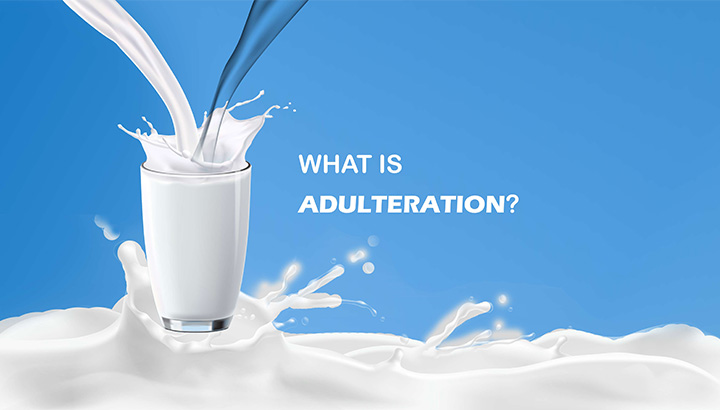
Understanding Dairy Adulteration
What is Dairy Adulteration?
Dairy adulteration refers to adding unauthorized or harmful substances to milk and dairy products to increase quantity, alter taste, or improve appearance. Some adulterants can cause serious health risks, violate food safety regulations, and damage the reputation of dairy businesses.
Common Dairy Adulterants and Their Effects
| Adulterant | Purpose | Health Risks |
| Water | Increases volume | Lowers nutritional value, increases contamination risk |
| Starch | Thickens milk | Indigestion, nutrient dilution |
| Urea | Increases nitrogen content | Kidney damage, metabolic disorders |
| Hydrogen Peroxide | Preserves milk | Gastrointestinal irritation, potential toxicity |
| Detergents | Creates artificial froth | Fungal toxins in contaminated feed |
| Formalin (Formaldehyde) | Increases shelf life | Carcinogenic, toxic to organs |
| Aflatoxin M1 | Fungal toxin in contaminated feed | Liver cancer, immune suppression |
| Antibiotic residues | From improper cattle treatment | Antibiotic resistance, allergic reactions |
Why Dairy Adulteration is a Serious Issue
🔸 Public Health Concern – Contaminated dairy can cause long-term health problems.
🔸 Legal Consequences – Dairy adulteration violates food safety regulations and can result in severe penalties.
🔸 Economic Impact – Adulteration leads to loss of consumer trust and business credibility.
How to Detect Dairy Adulteration
Methods for Detecting Common Adulterants
1️⃣ Physical Observation
- A frothy appearance may indicate detergent.
- A yellowish or bluish tint can suggest the presence of chemicals.
- Unusual taste or odour could be a sign of spoilage or adulteration.
2️⃣ Simple Home Tests
- For Starch – Add a few drops of iodine to milk; a blue-black colour indicates starch.
- For Water – Place a drop of milk on a smooth surface; if it spreads quickly, it may be diluted.
- For Detergents – Shake milk vigorously; excessive foam suggests detergent.
3️⃣ Laboratory & Rapid Test Kit Detection
To ensure accurate results, professional rapid test kits precisely and reliably detect adulterants, antibiotics, and toxins in milk.
Our Advanced Rapid Test Kits for Dairy Safety
✅ Antibiotic Residue Detection
- 4in1 BSCT (Beta Lactams + Streptomycin + Chloramphenicol + Tetracyclines) – Detects multiple antibiotic residues in milk, ensuring compliance with safety regulations.
- 3in1 BST (Beta Lactams + Sulfonamides + Tetracyclines) – Focuses on three major antibiotic groups to prevent contamination.
- 2in1 BT (Beta Lactams + Tetracyclines) – A quick and reliable test for detecting two common antibiotic residues.
✅ Aflatoxin M1 Testing
- Aflatoxin M1 Quantitative Rapid Test Kit – Provides precise, measurable results for detecting Aflatoxin M1 levels in milk, ensuring compliance with regulatory limits.
- Aflatoxin M1 Qualitative Rapid Test Kit – Delivers a quick pass/fail result, allowing for rapid contamination screening.
✅ Milk Composition & Quality Testing
- MST1 – Milk Test Strips – Detects neutralizers, hydrogen peroxide, and urea to ensure milk purity.
- MST2 – Test Strips for Titratable Acidity – Measures the acidity level of milk to determine freshness and processing suitability.
- Peroxide Test Strips – Detects the presence of hydrogen peroxide, often added to extend shelf life.
- Alkaline Phosphatase (ALP) Testing – Ensures proper pasteurization by detecting enzyme activity in milk.
- Resazurin Test – Evaluate the microbial load in milk to determine hygiene levels.
✅ Adulterant Detection
- Milk Test Strip for Starch – Identifies starch adulteration, which can falsely increase milk thickness.
- Milk Test Strip for Sucrose – Detects added sugar, ensuring that milk quality is not compromised.
✅ Additional Dairy Testing Tools
- Lactometer – Measures milk density to detect dilution with water.
- Alcohol Gun – Determines milk stability by detecting excess acidity, which indicates spoilage or bacterial contamination.
Why Regular Testing is Essential
✔ Ensures Consumer Safety – Prevents health risks from adulterated dairy.
✔ Maintains Product Quality – Helps dairy producers uphold industry standards.
✔ Meets Regulatory Requirements – Compliance with food safety laws avoids legal issues.
Preventing Dairy Adulteration
Best Practices to Ensure Dairy Purity
🔹 Implement Strict Quality Control Measures
- Test milk at different processing stages using our rapid test kits.
- Regularly audit suppliers to ensure they adhere to food safety standards.
🔹 Maintain Proper Hygiene & Storage
- Store milk at 4°C (39°F) to prevent bacterial growth.
- Use sanitized containers to avoid contamination.
- Ensure dairy processing equipment is thoroughly cleaned.
🔹 Educate Farmers & Dairy Producers
- Train suppliers on the dangers of chemical adulteration.
- Promote the use of natural preservatives instead of harmful additives.
🔹 Use Regulatory-Compliant Testing Methods
- Adopt routine testing protocols for all dairy batches.
- Invest in affordable and efficient test kits to detect adulterants quickly.
How Dairy and Food Consulting Limited Can Help You
At Dairy and Food Consulting Limited, we provide trusted, high-quality rapid test kits to help dairy businesses detect and prevent adulteration effectively.
✅ Fast & Reliable – Results available within minutes.
✅ Easy to Use – No advanced lab equipment required.
✅ Regulatory Compliance – Meets international food safety standards.
Get in Touch with Us!
💡 Ensure Dairy Safety with Our Rapid Test Kits!
📞 Contact us today for expert solutions in dairy testing and food safety.
📍 Dairy and Food Consulting Limited – Your Partner in Dairy Quality Assurance!